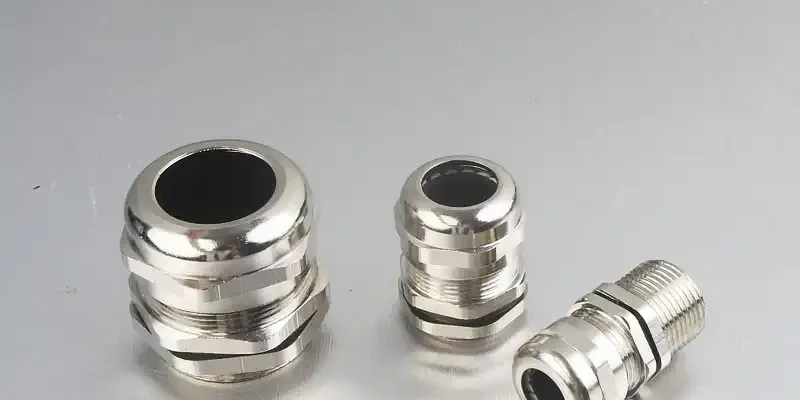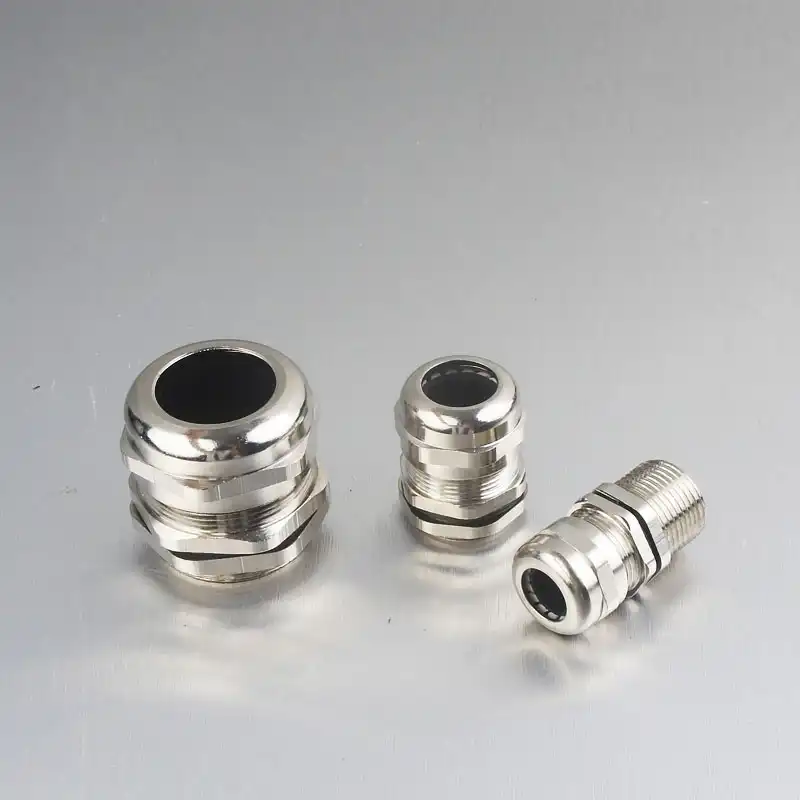Poniklované mosazné kabelové vývodky jsou základními součástmi elektrických systémů, které zajišťují bezpečné vstupy kabelů a ochranu před vlivy prostředí v různých průmyslových, námořních a nebezpečných aplikacích. Tato univerzální zařízení nabízejí vynikající odolnost proti korozi, trvanlivost a možnosti přizpůsobení, což z nich činí preferovanou volbu pro zajištění bezpečných a spolehlivých elektrických připojení v náročných prostředích.
Kabelová vývodka VIOX z poniklované mosazi
Složení a ochrana materiálu
Tyto kabelové vývodky se skládají z mosazného základu, slitiny mědi a zinku, která je známá svými vynikajícími mechanickými vlastnostmi, a jsou opatřeny niklováním, které výrazně zvyšuje jejich odolnost proti korozi, opotřebení a vlivům prostředí. Niklová povrchová úprava poskytuje nejen vynikající ochranu proti vlhkosti, chemikáliím a slané vodě, ale také zlepšuje estetický vzhled vývodek. Výsledkem této jedinečné kombinace materiálů je výrobek, který nabízí:
- Vynikající mechanická odolnost, schopnost odolávat namáhání, vibracím a nárazům.
- Zvýšená odolnost vůči slabým kyselinám a různým chemikáliím
- Lepší výkon v prostředí slané vody
- Zachovaná elektrická vodivost mosazi s dalšími ochrannými výhodami
- Prodloužená životnost díky zvýšené odolnosti proti korozi a degradaci v průběhu času.
Hodnocení a typy výkonů
Tyto kabelové vývodky se obvykle vyznačují krytím IP68, které zajišťuje prachotěsnost a ochranu proti dlouhodobému ponoření do vody. Mohou účinně pracovat v širokém rozsahu teplot, často od -30 °C do +100 °C. K dispozici jsou různé typy vyhovující různým potřebám:
- Jednoduché kompresní vývodky pro nepancéřované kabely
- Dvojité kompresní vývodky se zvýšeným těsněním pro pancéřované i nepancéřované kabely
- Nevýbušné vývodky pro nebezpečná prostředí
- Pancéřové kabelové vývodky pro mechanické udržení a elektrickou kontinuitu
- Vícedrátové vývodky navržené pro uložení více kabelů v omezeném prostoru
Pokyny pro instalaci
Při instalaci kabelových vývodek z poniklované mosazi je třeba dodržovat správné postupy, které zajistí optimální výkon a dlouhou životnost. Zde jsou klíčové pokyny, které je třeba vzít v úvahu:
- Vyberte příslušnou žlázu: Vyberte kabelovou vývodku správné velikosti a typu pro konkrétní kabel a aplikaci. Zvažte faktory, jako je průměr kabelu, podmínky prostředí a požadovaný stupeň krytí (např. krytí IP68).
- Připravte kabel: Odizolujte plášť kabelu, abyste odhalili vodiče, a zajistěte, aby délka kabelu byla vhodná pro vývodku a kryt. Dávejte pozor, abyste nepoškodili vnitřní vodiče nebo izolaci.
- Vložte kabel: Provlékněte kabel tělem vývodky a ujistěte se, že jsou obnažené vodiče dostatečně dlouhé, aby dosáhly na zakončovací body uvnitř skříně.
- Utáhněte vývodku: Připevněte vývodku ke skříni pomocí pojistné matice a zajistěte její těsnost. Pomocí momentového klíče dosáhněte utahovacího momentu doporučeného výrobcem, obvykle udávaného v newtonmetrech (Nm).
- Kabel utěsněte: Utáhněte přítlačnou matici, abyste vytvořili vodotěsné těsnění kolem kabelu. U vývodek s dvojitým těsněním se ujistěte, že jsou vnější i vnitřní těsnění řádně stlačena.
- Zkontrolujte, zda správně sedí: Zkontrolujte, zda je kabel pevně uchycen a zda mezi vývodkou a pláštěm kabelu není viditelná mezera.
- Připojení k zemi: U pancéřových kabelů zajistěte správnou elektrickou spojitost mezi pancířem kabelu a tělesem vývodky, aby bylo uzemnění účinné.
- Ochrana životního prostředí: V korozivním nebo mořském prostředí naneste na závity malé množství nevodivého maziva, abyste zabránili zadření a zvýšili odolnost proti korozi.
- Úleva od tahu: Proveďte správné vedení kabelů, abyste zabránili nadměrnému namáhání vývodky a kabelového připojení.
- Závěrečná kontrola: Po instalaci proveďte vizuální kontrolu, a pokud je to možné, proveďte zkoušku tahem, abyste se ujistili, že je kabel bezpečně upevněn.
Dodržováním těchto pokynů mohou montéři maximalizovat účinnost poniklovaných mosazných kabelových vývodek, zajistit spolehlivou ochranu proti vlivům prostředí a zachovat integritu elektrických spojů v náročných průmyslových aplikacích.
Různorodé aplikace
Charakteristickým znakem těchto robustních komponent je všestrannost, která nachází uplatnění v celé řadě průmyslových odvětví. V průmyslovém prostředí zajišťují spoje v těžkých strojích a výrobních zařízeních, zatímco jejich odolnost proti korozi je ideální pro námořní prostředí vystavené slané vodě. Jejich spolehlivost je výhodná i pro odvětví obnovitelných zdrojů energie, kde se používají v solárních systémech a větrných turbínách. Jejich odolnost a těsnicí schopnosti z nich činí klíčové prvky v nebezpečných oblastech, jako je ropný a plynárenský průmysl, kde jsou pro bezpečnost nezbytné nevýbušné prvky. Tato široká škála aplikací podtrhuje přizpůsobivost a význam poniklovaných mosazných kabelových vývodek při zajišťování bezpečných elektrických spojení v různých a náročných prostředích.
Dopad na životní prostředí a udržitelnost
Poniklované mosazné kabelové vývodky mají několik výhod pro životní prostředí a udržitelnost, takže jsou zodpovědnou volbou pro dlouhodobé elektrické instalace. Jejich trvanlivost a odolnost proti korozi přispívají k prodloužení životnosti výrobků, což snižuje potřebu časté výměny a minimalizuje množství odpadu. Recyklovatelnost mosazných součástí je v souladu se zásadami oběhového hospodářství, protože tyto materiály lze po skončení jejich životnosti regenerovat a znovu použít.
- nižší dopad na životní prostředí díky delší životnosti ve srovnání s plastovými alternativami
- Snížení požadavků na údržbu, úspora zdrojů a energie v průběhu času.
- Potenciál pro recyklaci a využití materiálů, podpora udržitelných postupů
- Soulad s RoHS zajišťuje minimální použití nebezpečných látek.
Proces niklování má však určité environmentální aspekty, včetně spotřeby energie a možného chemického odpadu. Výrobci stále častěji zavádějí ekologičtější techniky pokovování a postupy nakládání s odpady, aby tyto dopady zmírnili. Vzhledem k tomu, že se průmyslová odvětví zaměřují na udržitelnost, dlouhá životnost a recyklovatelnost poniklovaných mosazných kabelových vývodek je staví do pozice ekologičtější volby pro elektrickou infrastrukturu.
Ekologicky šetrné výrobní procesy
Výroba poniklovaných mosazných kabelových vývodek zaznamenala významný pokrok v ekologických výrobních procesech, které řeší otázky životního prostředí a zároveň zachovávají kvalitu výrobků. Moderní výrobci zavádějí čistší technologie, aby snížili ekologickou stopu těchto základních komponent:
- Roztoky niklování na vodní bázi nahradily tradiční metody založené na rozpouštědlech, čímž se výrazně snížily emise těkavých organických látek (VOC).
- Uzavřené systémy pokovování recyklují a znovu používají chemikálie, čímž minimalizují množství odpadu a šetří zdroje.
- Energeticky účinné techniky galvanického pokovování, jako je pulzní pokovování, snižují spotřebu elektrické energie a zároveň zlepšují rovnoměrnost povlaku.
- Zavedení zařízení s nulovým vypouštěním zajišťuje, že během výrobního procesu nedochází k vypouštění škodlivých odpadních vod do životního prostředí.
Díky těmto inovacím jsou kabelové vývodky z poniklované mosazi nejen ekologičtější, ale často také dosahují vyšší kvality a výkonu, což zvyšuje jejich odolnost a životnost v náročných průmyslových podmínkách.
Přední výrobci kabelových vývodek
Několik předních výrobců vyrábí vysoce kvalitní poniklované mosazné kabelové vývodky pro různé průmyslové aplikace:
- VIOX Electric Tech: Čínský výrobce specializující se na poniklované mosazné kabelové vývodky s vynikající těsnicí schopností.
- Appleton (Emerson Electric Co.): Známá je jejich řada E1FW, která nabízí nevýbušné provedení a zvýšené bezpečnostní třídy pro nebezpečná prostředí.
- HELUKABEL: Nabízí širokou škálu mosazných kabelových vývodek se stupněm krytí IP68 a splněním mezinárodních certifikací.
- RS Pro: Nabízí poniklované mosazné kabelové vývodky s krytím IP68 a provozními teplotami od -40 °C do +100 °C.
- Anamet: Vyrábí kabelové vývodky s dvouvrstvým těsněním z EPDM, vhodné pro kolejové aplikace a certifikované podle norem EN45545-2.
Tito výrobci jsou uznáváni pro kvalitu svých výrobků, inovativní design a dodržování mezinárodních bezpečnostních norem, díky čemuž jsou jejich poniklované mosazné kabelové vývodky vhodné pro náročné průmyslové aplikace a aplikace v prostředí s nebezpečím výbuchu.



